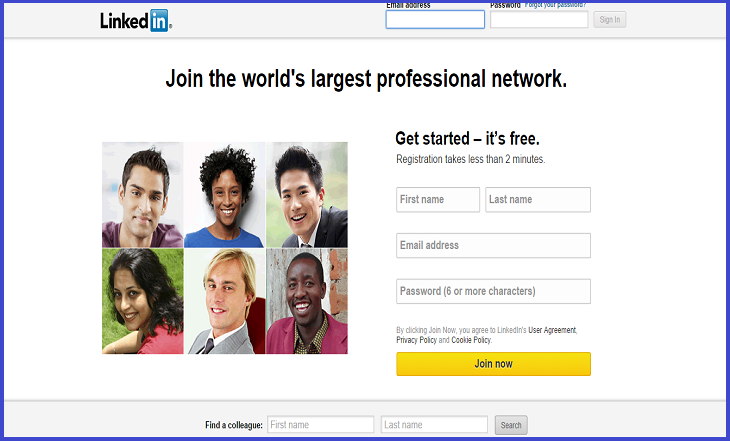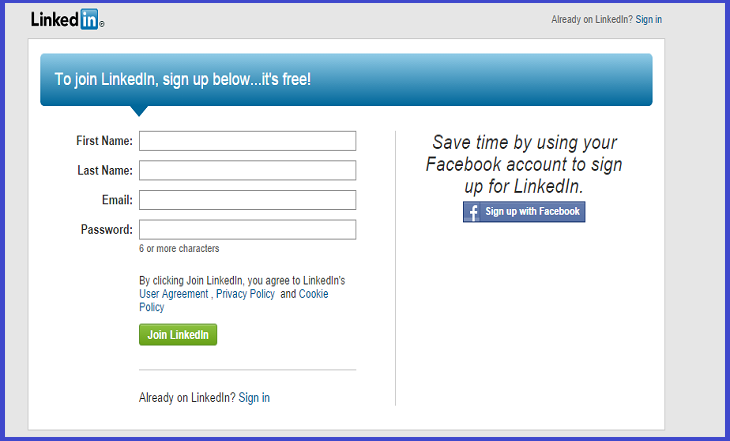
Www.Linkedin.com Log in – Sign in Home [ How to use linkedin.com ]
LinkedIn is the largest powerful tool for making business connections and most dominant social network in the professional areas. Even the most active users miss on some simple ways to optimize the way they use LinkedIn. Totally different from the likes of Facebook, it is used for maintaining a professional persona and brand. Other uses for LinkedIn include finding a job, networking, recruiting new employees, getting sales leads and even getting your business news.

Steps to Signing Up with LinkedIn :
- Join LinkedIn at their website. Click on the link, add your relevant personal information, and click “join LinkedIn.”


1. Create your profile:
Your profile is the condensed picture of how the professional world sees you. A great, detailed profile projects someone who is successful, thorough, and connected. A thin or outdated profile projects someone who doesn’t care or who can’t be bothered. Make sure your profile says the thing(s) you want to project.

- Make sure you have a professional photo and a catchy headline.
- LinkedIn’s profile wizard will take you through the steps of entering your region, industry, company and current job title.
- You will also be asked whether you are employed, a business owner, looking for work, working independently or a student.
- Customising the website links and especially your profile URL is crucial for optimising your profile .
- This information completes your basic profile.
2. Confirm the email account you used to create your profile via the link provided:
This will help you efficiently complete the next step, which is finding connections.
- Connections are professional contacts whom you know or wish to know. The connections you add on LinkedIn become part of your social network.
- LinkedIn will prompt you to search for connections by crawling your email, which you give LinkedIn access to. You can use this to see who among your email connections already has a LinkedIn account and invite them to become part of your professional network.
- You may opt to skip this step if you prefer to add connections individually.

3. Continue to build your profile:
Enter your previous employment details and your education information. Then enter a brief summary and/or headline. A brief summary or headline stating who you are professionally in a few sentences. This headline should give a sense of your most outstanding professional attributes.

4. Upload a profile photograph:
- Unlike other social networks, this picture should reflect you at your most professional. No pictures of binge drinking, girls around the arm, or smoke wafting from the background, even if it’s a reallygood picture. Choose an illustration that represents your professional image. This can be a traditional head and shoulders shot, a shot of you at work or a copy of your logo.
- Use a clear, vertical rectangular image.

5. Add specialties to your profile:
Including specific skills or specialties, such as veterinary dentistry or congressional campaign communications, allows other users can find you more easily.

Steps to Starting out with LinkedIn :
1. Ask for recommendations:
LinkedIn allows you to ask connections for recommendations and post them to your profile. You will see the recommendations and approve the postings. This feature reinforces the information in your headline summary and specialties sections. Prospective employers and clients browsing your profile will see these recommendations, as will the connections of those who have recommended you.
Linkedin recommendations are known for being overly positive and therefore not especially exciting. Focus requests for recommendations on people who can talk best about your skills, such as ex bosses and customers.

2. Join and participate in LinkedIn groups:
You can increase your network and your visibility by starting and contributing to discussions. Local groups will inform you of networking activities and events.

3. Continue to build your network on a regular basis, adding new connections with a personal note of invitation:
A good rule of thumb is to only add those connections who you could envision giving you a good recommendation. Think twice before adding connections who aren’t too fond of you or any of your companies or businesses.

4. Stay in contact with your connections:
Respond to their updates by sending them notes of congratulations on a new position or achievement. The most important connections to nurture are the ones from previous jobs, or other people you haven’t spoken to in years.
